
Whether we’re aware of it or not, we basically move through life in one of two ways, and each of us has a favorite. We’re either moving towards what we want, or we’re moving away from what we don’t want.
It might seem like moving away from what you don’t want accomplishes the same thing as moving towards what you do want. If you’re successfully moving away from pain, dullness and disappointment, what could you be moving towards, other than pleasure, excitement and fulfillment? It should be a simple matter to decide which way to go.

Unfortunately, life doesn’t resemble a straight line with evenly distributed incentives. It’s a whole field of possibilities. There are always many places to go from wherever you are in a given moment. What you want and what you don’t want are scattered all over the place, sometimes hiding behind each other, sometimes mixed together.
Here’s a simplified version of the field of possibilities that might be on your mind at a given time:
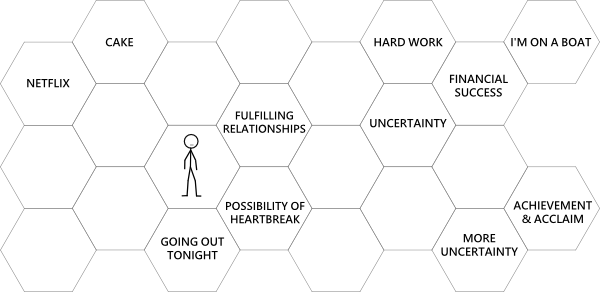
Life is always a complex landscape of possible paths, and what’s available to you at any given juncture is a result of how you tend to move through the field.
How you tend to move through the field depends largely on whether you’re mainly concerned with staying away from the undesirable stuff, or moving towards the good stuff.
Many of us take the “moving-away” approach as our normal mode of operations. Because of certain past experiences and preoccupations, we’re generally more concerned with avoiding bad possibilities than seeking good ones. They loom much larger in our minds, they more easily make our blood move and our minds light up.
In fact, when a bad possibility gets really close, or even might get close, the good possibilities become nearly invisible to us. We panic and flee in the opposite direction.
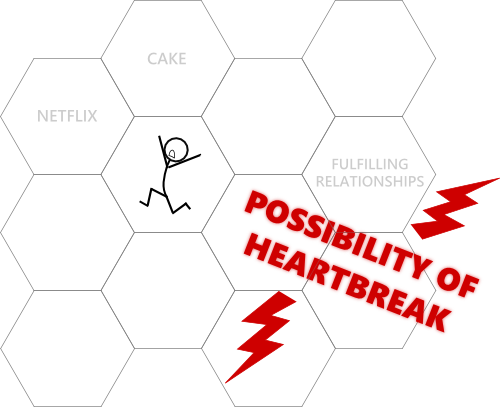
Meanwhile, in the distance, we see high-achieving peers and strangers who don’t seem to be as wary of disastrous possibilities. They walk right into them yet they never seem to get stuck in them. They don’t seem to think much about problems, and are concerned instead with what they want and what they’re going to do.
These people are operating with an altogether different mentality. The difficult and obnoxious things on their respective paths clearly aren’t at the forefront of their minds. They move into and through the things they don’t want, simply because they happen to lie in the same direction as the things they want. In their minds the goal is always bigger, more consequential, more deserving of respect than the pains and dilemmas along the way.
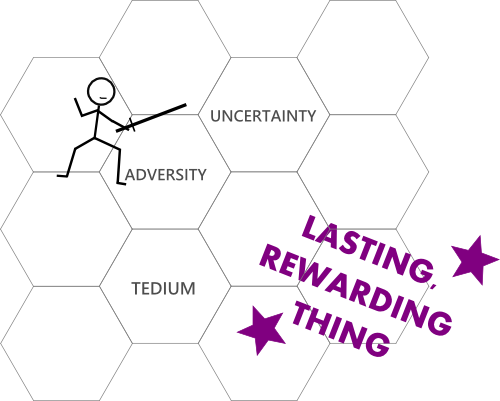
Those who employ a moving-towards philosophy are able to traverse all the areas of the field. They still experience fear and pain, but they’re aware of the limiting effect of letting negative possibilities become their primary motivators. They insist on determining their own direction across the terrain, scaling hills and crossing bogs if necessary, because it’s better than being stuck on the few meandering strips of land that don’t present anything tough.
We’ve all experienced both ways of moving through the world, but most of us probably employ one approach most or all of the time.
I am a multi-decade veteran of the moving-away approach, and I feel qualified to tell you it’s not a very good one. It has three big flaws that make it clearly the worse of the two.
Firstly, when you’re moving away, you’re not concerned about the overall direction of your movement. You just want to stay out of harm’s way. Usually that means you’re moving towards low-risk, low-reward options. Generally this means moving back to familiar territory, where you have the same limitations you always had, and little chance to grow.
Although it may not feel like it on a day-to-day basis, essentially you’re just drifting with the tide. The greater forces in the world decide where you will go, over your days and your years.
Secondly, because you’re drifting, you end up getting stuck in little corners and eddies where there aren’t a lot of options, and where the good stuff is farther than ever. It’s only ever small parts of the overall field that are far enough from painful and uncertain possibilities for you to feel safe. And these safe patches always collapsing and moving.
You frequently find yourself in these cramped little spots without a lot of personal power or opportunity available to you.
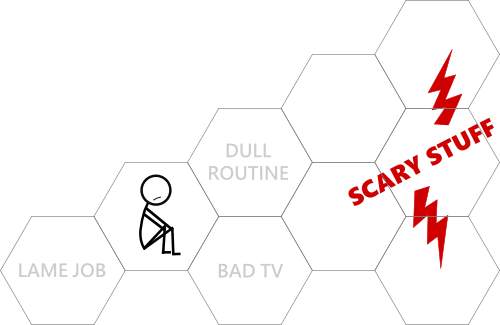
The third and most damning flaw of the moving-away approach is the kind of person it makes you. Moving away from the bad requires completely different survival skills than moving towards the good. Each approach nurtures polar opposite personal qualities.
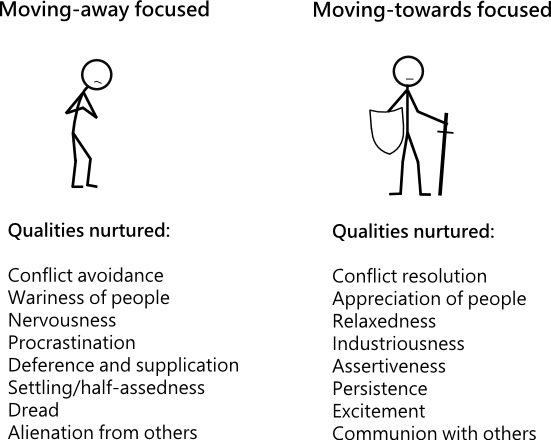
Moving-towards has its own potential pitfalls, such as the possibility of greed and arrogance. But when you’re moving towards, you tend to learn from pitfalls because they remain in your path until you figure out how to manage them. When you’re moving away, you tend not to learn much from your missteps, because you refuse to come back.
You probably already know which approach you usually employ. Going from one tendency to the other is possible, at least gradually. So much of our behavior is habitual, under-the-radar stuff. The more strongly we’re motivated by what we don’t want, the less likely we are to recognize when we’re doing it, because it’s just so normal to us.
The ability to change your main approach depends on gaining an awareness of those two forces, the push and the pull, in everyday life. When you make a life-related choice, are you fleeing something or advancing on something?
For everything we’ve run from, there’s something we desired that drew us far enough into new territory that we got scared and fled. What was it? When you notice you’re moving away from something, what was it you initially wanted to move towards? And what will you do if they’re in the same direction?
That simple question goes a long way: what was it that I wanted? You’re either moving towards it, or away.
***
 I'm David, and Raptitude is a blog about getting better at being human -- things we can do to improve our lives today.
I'm David, and Raptitude is a blog about getting better at being human -- things we can do to improve our lives today.
This makes me think of the famous William Blake quote: “The road of excess leads to the palace of wisdom…You never know what is enough until you know what is more than enough.” It seems he’s talking about a bold, adventurous approach to life, akin to your moving-toward advice.
Good old Blake. I love the romantics. They were definitely invested in the “moving towards” angle.
David,
You’ve raised some interesting points here. I’m still trying to find that balance between avoiding pain and pushing forward mindset. After your post, I think it may be best to focus on moving forward while being sufficiently self-compassionate to take care of yourself when you fall down, because you will if you are going to go the harder road.
Thanks for sharing!
Cheers,
Anh
That sounds like a good balance to me. The moving forward mindset might result in more bruises, but you’ll also develop the skills for tending to them.
In other words: it’s always a choise between love or fear.
But after years of running “towards” and “from” I realised (partial credit to you, David ;) that there is no need for running at all. It’s already ok! I try to Love the place where I am now. Do what comes naturally. Do not fight. Relax, breath and do the job at hand. Be flexible, open to new opportunities. Sit still. Breathe. Wu wei. Flow. Be like water. Just show up etc…
Definitely — whichever direction we’re heading, we suffer to the extent that we resent the present. But that’s true regardless of which approach you take.
One way to make it easier to be where you are is to know that your overall direction is towards a better situation, which is something the moving-towards mentality can offer that the other can’t.
Your post has come at a fortuitous time as I’m struggling. Thank-you for giving me clarity on this particular point.
Best of luck to you Lorelle.
I always look forward to David’s posts and this is a beautifully clear and to the point piece. I recognise too much of myself in the “moving-away” focussed qualities (but some in the “moving-towards” too!). A lot of this applies not just with life’s overall direction but with lesser goals and tasks, such as in my own field of language learning, so much of which is about mastering difficult skills and about communication and connection.
That’s a good point… makes me think of how bad my guitar practice always was. I was afraid of tedium so I would just play the things I already knew, and learned very very slowly. And I’m still terrible :/
I actually figured this stuff out too, a few years ago. I realized that although I was doing work I loved (computer programming), I nevertheless couldn’t really put my heart and soul into it. I could spend days writing 10 lines of code, just staring at the screen, not being able to focus, and eventually dropping back into browsing the internet. So I started thinking about some people whom I knew who were very self-motivated. I wondered what they thought, how they saw life – and after a few weeks of deliberation (nope, didn’t talk to them), I finally arrived at this very same thing. Here’s a bit more, from what I figured out:
Everything that we do, from going to the bathroom in the morning to attending a business conference, is because of one of two things – either we’re afraid of what will happen, if we don’t do X; or we want something that will happen, if we do X. Also known as stick and carrot. However the traditional “stick and carrot” usually refers to external factors, while in this context I’m talking about everything that we experience, including inner emotions. Nobody might ever notice how neatly you’ve arranged socks in your drawer, but it gives you a nice warm feeling of order, and that is what counts.
All in all, these two things are simply two emotions – fear and desire. No other emotions move us to actions, just these two, and any of our actions have one of these emotions behind them. Or often even both, in different doses (because emotions do have a scalar “strength” value).
There are a few side-effects of both fear and desire.
– Fear is easier to provoke in other people. You just need to threaten them with something. Desire is much harder to invoke, you really need to know the other person well to do it. For this reason, most of the time people resort to a fear-based motivation when they want to compel another person to do something. Especially when that other person is a child (who tend to be difficult to be reasoned with), so most of us are exposed to a lot of fear-based motivation in our early lives. This tends to carry on and we start to do our self-motivation in the same way.
– Fear is draining. It can work powerfully in short term, but it’s a crappy long term solution. You either grow insensitive to it (apathy), burn out, or just move away from its source. So, I don’t want to demean it as a tool – sometimes it’s the right thing – but use it sparingly.
– In contrast, desire works well in long term, and keeps you happy with dreams of future success.
– Fear does not inspire to achieve greatness. You only work as hard as needed to remove the threat. There’s no reason to work harder than that. Thus, fear creates mediocre results.
– In contrast, desire prompts to go ever further. You reached this far, but if with a little extra effort you can double your gains – of course you’ll do it.
– Fear reduces rational thought and creativity, but increases focus. In the extreme case – panic – you are totally focused on one thing and one thing only, and nothing else exists. This holds true even when the fear is small. For this reason fear-based motivation works well in places that require mindless mechanical actions (like factory floors), but fails miserably for creative work. See also the Duncker’s candle problem.
– Sometimes a stick can masquerade as a carrot. For example, take the same candle problem. Or imagine a boss offering you a raise, IF you perform well on the upcoming project. At first it might seem like a carrot – perform well, and you get extra reward. A great reward, even. But the emotion that the employee feels is not that of desire – it’s fear. Fear of losing that raise, which is almost there, almost at hand, just… don’t lose it… perform well… This is another reason why it is difficult to motivate someone with desire. If they desire your reward too strongly, they will start to be afraid of losing it, and all fails. Instead, they need to desire it without the fear of losing it. That’s tricky.
Great comment, thank you Vilx.
I think the motivation style in workplaces is a huge factor in the way our society works. We tend to think of work as an annoyance, a thing we dislike and try to minimize, and I’m sure that has a lot to do with stick-based motivators.
Man, I’m in a similar situation. I generally really love computer science. My work isn’t bad too. But I can’t consistently focus. I wish I could do a great work, but I’m just doing what I can to keep going and not get fired.
I think it’s lack of motivation, but maybe it’s fear on the other side. Not so much my boss fault, but my own too. I have more fear of being mediocre than a desire to be great. I mean, I really wish to be great, but the thought that I’m doing a mediocre job and failing on some things makes me terrified and now, kind of apathetic.
Not sure what to do, and tried a lot of things from here and other places. Listening to happy upbeat music sometimes help, I think that I focus LESS on my goals and get less afraid because of that, concentrating on the music and on the task. But it’s tiresome after some time, and doesn’t work that well when I need to think deeply.
Hey Sohakes. The basic idea is to use those moments of fear of being mediocre as reminders of the flipside, which is how great it really does feel to finish some good work.
Well, in my case, after I figured out the above, the solution was simple – switch over from fear-based motivation to desire-based. Stop worrying about what happens if I lose my job, and start focusing on the aspects that I love about it (namely, programming). It doesn’t guarantee 100% concentration all the time, of course – there are other things that affect that too, like tiredness, etc – but I’ve never had a lack of motivation for work since.
LOVE this idea and the supporting graphics and metaphor. I’ll be taking this with me this week, especially as I navigate the job search and try to do so with a mindset of abundance rather than just fighting off the negative feeling of not having a job. Thanks David!
Job search sounds like a good test for it. I have a personal history of being so preoccupied with my fear of interviews and things going wrong that I almost forget the upside, which is getting an awesome new job.
I’ve been a ‘moving-away’ person for most of my adult life. Only recently have I been grappling with the effort to become a ‘moving-toward’ person. In a world filled with choice and possibility it’s so much easier to name what you don’t want instead of having the courage to name, and work for, what you DO. Thanks for the food for thought. This was a very timely post and I’ll be keeping it in mind when I apply for better, ‘moving-toward’ jobs later today!
Someone who emailed in had a good point. We can be movers-toward in one or two areas, even if we’re movers-away overall. So you could just pick one area and do a little more contemplation on what the desires are there.
One thing that occurs to me as I read this is that a person might easily use different approaches in different domains. I am squarely in the moving-towards camp in personal relationships, but am probably pretty far into moving-away behavior when it comes to professional goals. Interpersonally, I’m comfortable with uncertainty, discomfort, patience and hard work, but tend to run the opposite direction when presented with similar situations at work, where what I want is behind a bunch of those uncomfortable hexagons in your drawings.
This is what someone mentioned in the email I mentioned about. It made me think about which areas I am move-towards. I used to be move-away in virtually every area, but I have become move-towards when it comes to fitness/exercise and I’m starting to be when it comes to cleaning/household stuff and personal relationships. Work is in the middle :/
David,
Interesting post! I wonder if you’ve read the book, _Thinking Fast and Slow_, by Daniel Kahneman. The ideas and psychological research he discusses in that book add much to your post. He claims that many of the things that you’d like to change are subconscious mental patterns that we can’t do much to change, even if we’re aware of them.
That doesn’t mean we shouldn’t try influence those processes, but it does mean that we should be ready to try an indirect approach to addressing the behavior patterns outlined in your post: for example, rather than trying to fight our fear of conflict head-on, we’d do better to approach a potential conflict as a negotiation in which we want both parties to get at least part of what they want from the deal.
If you’ve read the book, I’d love to know your thoughts about it.
Thanks for writing,
-Greg
I have it on the bookshelf beside me. It’s probably time to actually read it. I guess its large size has had me fleeing for the hills :)
I love the idea of the indirect approach. Much experimentation will follow.
You will find that much of what you read in various places these days is really sourced in Kahneman.
Here is a decent summary of some of the take-aways:
https://erikreads.files.wordpress.com/2014/04/thinking-fast-and-slow-book-summary.pdf
I’m kind of disappointed nobody noticed the Lonely Island reference in this post.
https://www.youtube.com/watch?v=R7yfISlGLNU
If it helps I noticed that little cell that said “I’m on a Boat” and my subconscious said “That’s weird”, but didn’t make the connection. :-) Thanks for this post, it’s what I needed to hear today.
Haha, nooo, I did notice it! But honestly I thought there’s no way you could reference it, so I left it at “random”. Assumptions, assumptions :)
Oh, I picked up on that right away! I wanted to say, “but I AM on a boat!”
This was a great post and the illustrations were helpful.
This all reminds me of Brene Brown’s work in Daring Greatly and Rising Strong, and I love it all!
Great post. After I opened the doors of perception and saw life for what it is, I decided to spend the rest of it “moving towards”. Everything changed for the better. I have a deep sense of happiness, fulfillment and wellbeing which stems from the consistent growth I’ve experienced by setting scary goals, getting out of my comfort zone, challenging myself and learning. The new skills, abilities, self confidence, wealth, relationships, expanded vision of whats possible are just the tip of the iceberg.
Netflix and cake – brilliant.
Hi!
This article is full of shit and here is why:
Take the following line for example:
“They still experience fear and pain, but they’re aware of the limiting effect of letting negative possibilities become their primary motivators”
And let’s take the goal of achieving a stable, loving romantic relationship as a context for this quote. You have two people: one is considered by society to be very attractive, and the other is considered to be, not so attractive. All things being equal the attractive person is going to have more opportunities and invitations to explore different romantic relationships, wheras the person who is less attractive will just have less opportunities for success. If a person is extremely physically unattractive, it’s not inconceivable they may go years in between finding sexual partners.
Going by this article, you may be tempted to suggest the beautiful person was able to find love because they were just braver in their search and were willing to experience the pain of temporary rejection in the greater search for love, whereas the unattractive person just wasn’t brave enough to face rejection, after rejection after rejection.
This is just total bullshit and makes heroes out of people that are blessed by life with certain positive traits, and it takes people who don’t necessarily excel at life and say it’s their fault for having a bad attitude.
If you don’t know the pain of what it is to be unattractive in society it’s so easy to tell that person they need to be aware of their choices and develop resilience, but there is a reason people are the way they are, and it is the hight of hubris to suggest if you were that person you would live your life any different, or in a more courageous manner.
Essentially, some people’s potential bad experiences are more bad than others, and other people’s good experiences are better than others?
I think your example of “extremely unnattractive” person is a bit disengenuous. There’s a lot more than physicality and genetics, attitude and styling and intelligence and success and caringness and humour etc all make up a person; at least some of these characteristics are a matter of choices, and greatly impact how the physical being of a person is seen.
That’s not to say you’re not right, that different people still have different payoffs available to them and for that reason their choices may be different still, yet still rational. (It just sounds like you might be talking about yourself, and honestly, when someone’s attractive, looks are a paper thin part of that, easily torn up by someone being a terrible or sad or a plain boring unfulfilled scared person.)
Bringing up an example that tests a presented theory can lead to further discussion and elucidation about the subject at hand. However, beginning your critique with “This article is full of shit…” is unlikely to be conducive to an ongoing conversation. But perhaps having a dialogue was not your goal.
I always find inspiration in your words. And sometimes they remind me to previous pieces of though that have written, some of them published. This entry reminds me to a text that made me understand and overcome a bit my procradination and some fears.
I humbly share the link of the text that someone may find useful. Thanks for your work.
http://goo.gl/2chFgH
Hi David, great post once again! I’ve been trying to be a moving towards guy and I’m less convinced of its constancy. It just requires too much energy. I guess you define yourself as a moving towards person if you move towards your goals often than the average person
It’s been a while since I feel like I’m constantly trying to move away from the behaviour that makes me move away from things I don’t want. D:
A lot of people don’t even know what they want, and spend all their efforts just trying to avoid more pain. Many feel that they are in a living hell, at home and at work, and their only strategy to avoid an even worse hell is just to work harder. Money is the only tool they’re offered, and the only solution they can imagine to their problems. Many people feel trapped in a society that doesn’t work for them, and only dream of escape, but don’t know how, or to where. “On a boat” is great, temporarily in the imagination as therapy, but it is not a plan for a solution.
Life is a zero sum game. There is no way around it.
To get something, you must give up something. To avoid something, you must give up something. Its the same thing.
To measure life by object-based success (be it positive emotions, relations, $$, status…. they are all just objects with reference to YOU, the subject) is an exercise in madness.
The only measure of success is the degree of self realization; not how many kisses you had or how many corporate dragons you slayed. All that vanishes like a fart in the wind.
We can deliberate on these approaches to live this illusion of life all we like but its akin to going really fast on a stationary bike; you are not really getting anywhere anyways.
All pursuits and tactics have one underlying reason: Freedom. Be it from your self generated negative emotions or from a genuine burning desire to want more from life (other than ‘stuff’). Freedom can only come from knowledge, not ‘more/better’ experiences.
The article has lots of merit nonetheless. Its first class; but for those that are still in the illusion.
Inspiring. Keep doing your great work down here please sweet soul!
Thank you!
Comments on this entry are closed.
{ 3 Trackbacks }